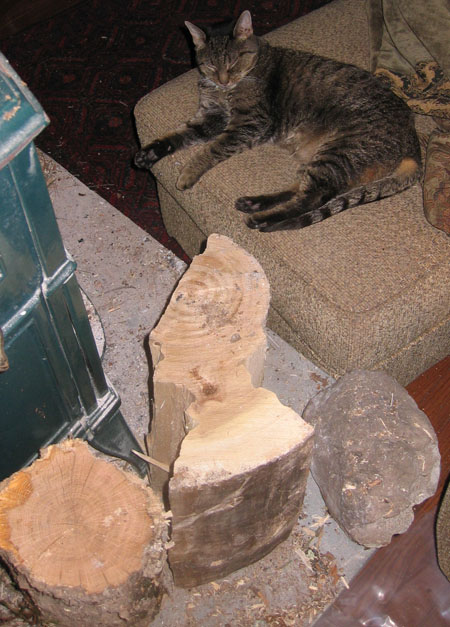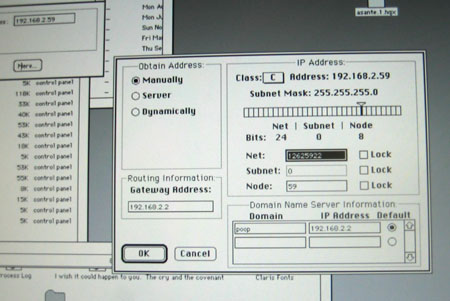|
|
|
aggravation for very little satisfaction
Wednesday, January 24 2007
In the wee hours of last night, I'd driven the Honda Civic hatchback to the corn field across Wynkoop from the Hurley Mountain Inn and gathered a number of large pieces of wood that someone (I suspect the Town or Village of Hurley) had deposited along the east bank of Esopus Creek. Judging from the prevalence of Norway and Colorado Blue Spruce, most of these pieces look to be fragments from trees that fell in suburban areas. I'd been less interested in the evergreen than I'd been in the massive pieces of tree trunk a little further on. These were each about five feet long and, in some cases, over two feet in diameter. I'd somehow been able to wrestle two such pieces into the back of my little car, along with various smaller pieces.
This morning, after a wide-ranging walk with the dogs in the forest, I cut up and split all the wood from last night. Unfortunately, though, those big pieces I'd gathered looked to be of some unfamiliar (and probably undesirable) firewood species. One piece didn't have any bark but the bark on the other suggested Cottonwood. Furthermore, the growth rings on this wood were nearly a half inch wide, meaning these huge pieces came from trees only about forty years old. Once I started splitting the wood, I was surprised to discover that it smelled like horse manure and was very moist inside. Evidently Cottonwoods (as I'm pretty sure this was) do not actively dessicate their interior rings as they grow (as in yesterday's entry I theorized that oak and maple do). I should have been suspicious that I could even lift pieces so big, and once the water evaporates it won't be much heavier per unit volume than balsa. It also has a strange splitting behavior, seeking to break along ring lines, something I've never seen with other firewood species. After an hour of work I'd split up a sizable pile of Cottonwood firewood, but I have my doubts I'll be able to burn it any time soon or that, when I do, it will produce much in the way of BTUs. As firewood goes, it's about as close to celery as one can get.

Here Marie poses near pieces of wood (and a rock) drying beside the fire. On the left is an old piece of oak (or perhaps Chestnut) from the nearby forest. In the middle is a piece of Cottonwood. Notice the weird way this piece split, with the split starting perpendicular to the rings and then, near the center, veering parallel to one of the rings.
The firewood ordeal was only my first experience today with putting in a lot of work for meager payback. The second came later today when I went through the processes (and there are many) necessary to connect my old Macintosh IIsi to the internet so I could, for a laugh, browse the web. For the fifteen years I've had it, the IIsi has always had a basic prerequisite for connecting to the internet: an ethernet card. Before I got it, this particular computer even had its own unique IP address on the internet. In my possession, though, it lived in a state of isolation. At some point I arranged a little LocalTalk network for it to communicate with an AppleTalk ImageWriter and one of the MacSEs (mostly for goofy games of Spectre, an impressive-for-the-time network tank battle simulator). I think I might have also dialed up a BBS on one occasion, just as a proof of concept (since it wasn't local and I didn't want to be yelled at for running up phone bills). But throughout the time I used the IIsi, though I had an ethernet card for it, I lacked an ethernet network to plug it into. In those days ethernet cards were expensive, so even though I also had various PCs throughout this time, nothing was ever networked over anything more advanced than serial lines. In those days I thought LocalTalk (which used the Mac's serial port as a network connection) was awesome and plenty sufficient for the sorts of communications I wanted to do. Ethernet just seemed like overkill.
Fast forward to today, with me finally trying to connect that old IIsi to an ethernetwork. I'd taken delivery of a transceiver, a necessary Mac-only networking ingredient, and some old SIMMs to pump up the IIsi's memory from five to sixty-five megs (something I would have allowed myself to be sodomized for back in the day). All that was left was to get the software in shape. This proved trickier than expected. I only needed a few files, but nowhere on the Internet can you just download the Appleshare extension or MacTCP - you have to download image files for a whole System 7 installation, which you then have to get onto floppies. And while my modern Macs were happy writing good old retro-compatible floppies using a USB floppy drive (normally attached to one of my Windows machines), none of the software on my modern Macs knew what to do with those old floppy image files. I rooted through my extensive floppy collection from the good old days, but that collection is incomplete and it seemed the files I needed were still down in Virginia. I did finally manage to find what I needed in the System Folder of the other ancient Mac, the Performa, but my struggles were far from over. Now I had to configure MacTCP.
For a company that made its name with its careful design of user interfaces, the window where one assigns an IP address to a classic Macintosh is pretty cryptic.

The place in this screen where you set the three most-significiant parts of the computer's IP address is under that scale with the slider, the form item labeled "Net:." Unlike the other places in this form, though, it doesn't accept a familiar four-part IP address (XXX.XXX.XXX.XXX). Instead you're supposed to type in a decimal number. I had no idea what the number was that corresponded to my desired IP address (192.168.2.57), and just kept browing the web for examples until someone had one that was close to the one I wanted. From there I had to experiment. (No one anywhere bothered to explain what the algorithm is for translating IP addresses to those decimal Net numbers.) It turns out that the number I needed was 12625922 (for the 192.168.2 part), followed by a Node number of 57. Doing the research and experiments to set this correctly was so frustrating that I actually gave up at one point and went off to look for Open Transport, which is a newer IP-configuration utility where everything is configured as simple IP addresses. But tracking down a version of that for System 7 was a bigger headache than just biting the bullet and figuring out the weird (and completely unnecessary) MacTCP voodoo.
Once I had MacTCP working, I found I could connect to the internet using the FTP client Fetch 3.0.3. This was how I managed to download a copy of iCab, a reasonably-modern Web browser that can run on old hardware. But it came as a .sit file, a compression format for which I had no decompression programs. I had StuffIt Expander for OSX and possibly OS9, but none of that stuff would work on my vintage equipment. And it seemed StuffIt Expander was nowhere to be found among any of my floppy disks. Normally you'd think that getting a copy of such a program via the internet would be easy, but it seems Allume.com, the modern owner of all the StuffIt intellectual property, had managed to purge the internet of all wild copies of the programs. If you want StuffIt in any of its many forms, you have to go through them. But when I finally caved and gave them my email address so they could send me to the secret download site, I found that the only versions they had available were for modern Macintoshes (OS9 and above). They'd killed all the ancestors of the program, making orphans out of all the people with old hardware and compressed archives. In the end, I did manage to find one website making an old copy of StuffIt Expander available, though I'm sure it's just a matter of time before Allume.com sends its master a cease and desist letter. Just because of how important this file is, I have decided to host it here as well. Download StuffIt Expander 3.51 now!! Totally Free!!!
Browing the web with a 24 MHz computer (it's overclocked from the stock speed of 20 MHz) is unlikely to excite anyone about the web's possibilities. Still, it's possible to get to web addresses and (more importantly) download things from the web. In the cases where I needed something specific, I'd first navigate to it quickly using my modern Windows machine, and then type the address of wherever I needed to end up directly into the web browser on the pokey Mac. And then, a minute or three later, the page would render.
It had been a lot of work and aggravation for very little satisfaction.
For linking purposes this article's URL is:
http://asecular.com/blog.php?070124 feedback
previous | next |

